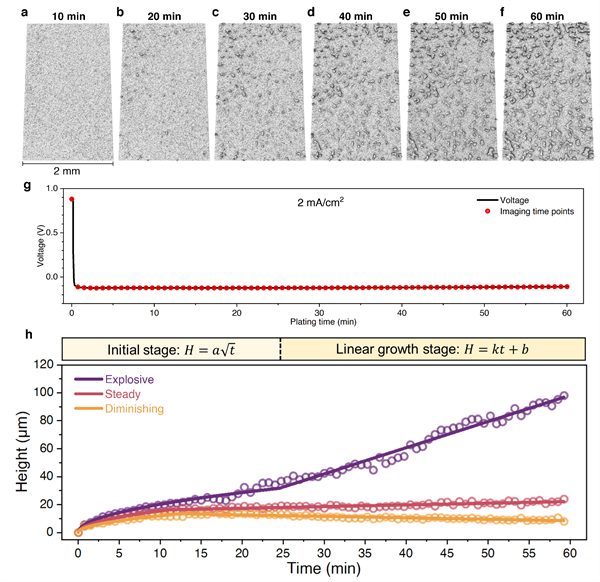
The study reveals three distinct modes in the complex electrochemical deposition of lithium metal — explosive, stable, and attenuated — providing new insights into the mechanisms underlying uneven deposition and dendrite formation. These findings offer important guidance for the development and optimization of dendrite mitigation strategies in lithium-metal batteries. In addition, the research provides valuable data to support AI-driven diagnostic model development, which could enhance the evaluation and optimization of lithium-metal anode safety.
Sung-Liang Chen and Shouhang Bo are the corresponding authors of the paper. GC doctoral students Jingying Zhou and Xingye Tang are the co-first authors, with doctoral student Xinyu Yu contributing to the study.

Lithium metal anodes have drawn great attention for their exceptionally high theoretical specific capacity and potential to enable next-generation high–energy-density batteries. However, the electrochemical deposition process of lithium metal is nonuniform and complex, leading to possible short circuits and capacity degradation. Predicting and controlling these effects remain major challenges, partly due to the limitations of existing imaging tools in capturing both fine structural details and wide-field morphological information.
To address this challenge, the research team developed a rapid photoacoustic microscopy system based on micro-electro-mechanical systems (MEMS) technology. The system enables non-destructive, three-dimensional, high-resolution imaging of lithium-metal deposition within tens of seconds. It can quantitatively track the dynamic evolution of lithium metal across different regions, making it a powerful tool for studying the intrinsic mechanisms of complex electrochemical processes.
Further analysis identified that spatial heterogeneity in the solid electrolyte interphase (SEI) diffusivity is a key factor driving the three observed growth modes. Regions with lower local diffusion coefficients tend to exhibit explosive growth and form protrusions, explaining the nonuniform nature of lithium deposition even within the same cell and electrolyte composition.
Author Introduction

Jingying Zhou
GC doctoral student
Research interests: In-situ characterization of multiphysical-chemical fields in solid-state batteries

Xingye Tang
GC doctoral student
Research interests: Rapid photoacoustic imaging technology

Sung-Liang Chen
GC Associate Professor and Doctoral Advisor, Senior Member of IEEE
Chen received his Ph.D. in Electrical Engineering from the University of Michigan in 2011 and completed postdoctoral research at the University of Michigan Medical School from 2012 to 2013. In 2015, he was selected for a national-level young talent program. His research interests include advanced optical imaging and AI-based medical imaging. He has published over 70 SCI-indexed papers, with works featured in journals such as Nature Photonics, Journal of the American Chemical Society, Lasers & Photonics Reviews, IEEE Transactions on Medical Imaging, and ACS Applied Materials & Interfaces.
